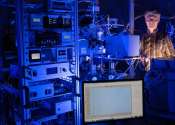Astronauts to undertake fourth walk to repair Hubble telescope
US astronauts on Sunday will undertake a fourth in a series of five daily spacewalks intended to equip the 19-year-old Hubble Space Telescope for at least another five years of valuable scientific work.








